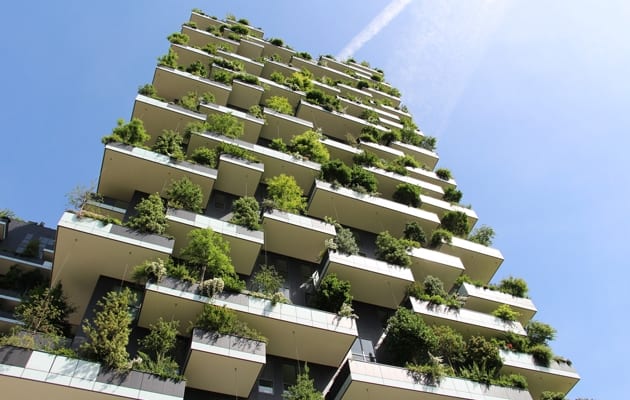 Bosco Verticale in Milan|||
Bosco Verticale in Milan|||
In the past decade, the race to build the world’s tallest building has been intensifying between corporate real-estate tycoons. The aspiration is to create more sustainable, communal and tech-savvy buildings, but there has always been an unspoken ulterior motive – who can build the highest. There are 1,478 buildings in the world that are more than 200m tall – this is an increase of nearly 150% from 2010.
We’re watching the most intense race in tall building history since the Chrysler versus Empire State Building showdown in New York in the late 1920s. The Chrysler Building momentarily won the competition for world’s tallest building by adding a magnificent 59m spire to garnish the top of the building – architect William Van Alen took his inspiration from automobile grilles. But Chrysler’s success lasted less than a year before the title was stolen by the Empire State Building with a rival, taller spire.
Today, as global cities are stacked with tall buildings, how can we ensure that we are creating human-centric environment, and not just concrete-glass-and-steel jungles? Milan might just have the answer. As city-dwellers are becoming more distanced from nature and natural elements, Italy’s second largest city has pioneered a new type of tall building in the heart of the conurbation in the form a vertical forest.
The Bosco Verticale are a pair of tall buildings which have a hectare of foliage planted on their façade in a bid to connect people living and working in the city to nature – and break up the sea of greyness. Completed in 2014 by architect Stefano Boeri, the buildings have won prestigious awards, including the Chicago Council on Tall Buildings and Urban Habitat (CTBUH) Best Tall Building Worldwide award.
Not only do these buildings connect people to nature, but they aim to reduce pollution by absorbing microparticles and CO2. The success of this concept led to the project being extended to Switzerland, Netherlands, Brazil and Albania.
 Bosco Verticale by Fred Romero
Bosco Verticale by Fred Romero
The Bosco Verticale are premium residential tall buildings, but corporates are now trying to cash in on their success. Italian insurance group UnipolSai is constructing its super-sustainable Milan office, which has been referred to as the eco-iconic tower. This office will include a series of winter gardens in the atrium and at the top of the building. Aiming for completion in 2020, Milan’s new tall building will stand at 125m, more than 100m shy of Italy’s tallest building, also in Milan, owned by the UniCredit bank.
According to the CTBUH, 80% of tall buildings in Milan are purpose-built as offices, and 80% are made from concrete. However, on a global scale, tall buildings are moving away from workplace as their core functionality, instead favouring mixed-use spaces. Almost half of the top 100 tallest buildings in the world in 2018 were built for mixed-use functionality.
Milan is catching on to this trend by developing a mixed-use district a short distance from the city centre. The new district, CityLife, will contain residential, commercial and business components, and large public green spaces. This moves away from the typical urban dialogue of grey and glass, and moves into the new era of mixed-use, green and destination districts.
Due for completion in 2019, the site is centred around three commercial towers which represent the second, third and fourth tallest buildings in Milan after the UniCredit building. It was masterplanned by Japanese architects Arata Isozaki + Associates, Zaha Hadid Architects and Studio Daniel Libeskind who designed the Allianz Tower, Generali Tower and PwC Tower respectively.
If you’re reading all this with growing incredulity, you’re not alone. Milan has a powerful reputation for opulent fashion, cool design and neoclassical architecture, so it can often be overlooked in Europe as a pioneer for the future of work and urban planning. Yet, in the past five years, it has quietly entered into the race for tall buildings.
The CityLife district demonstrates how Milan is leading global real estate trends by marrying tall buildings with corporate permeability to public and green space. Could Milan be the dark horse of urban innovation? London, Frankfurt and Paris, watch out.
As the global race to build even higher continues to intensify, somewhat surprisingly Italy’s design city is right at the heart of it






















